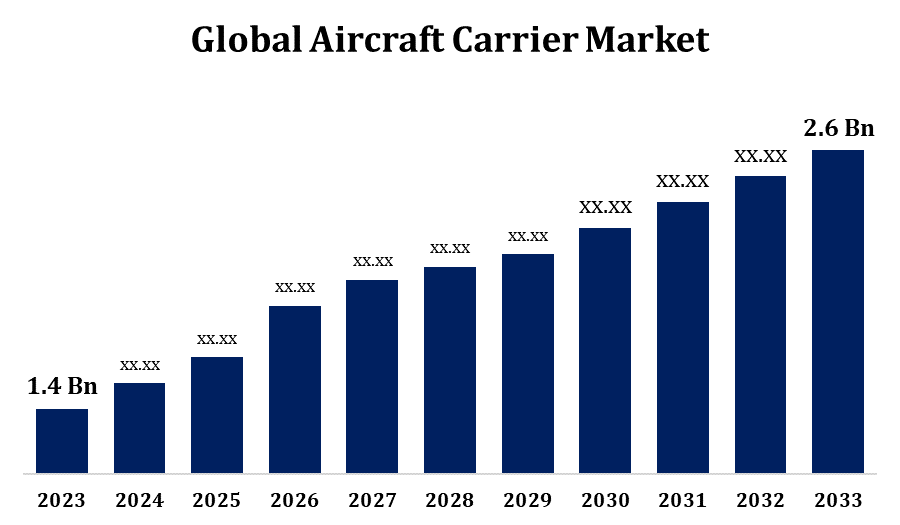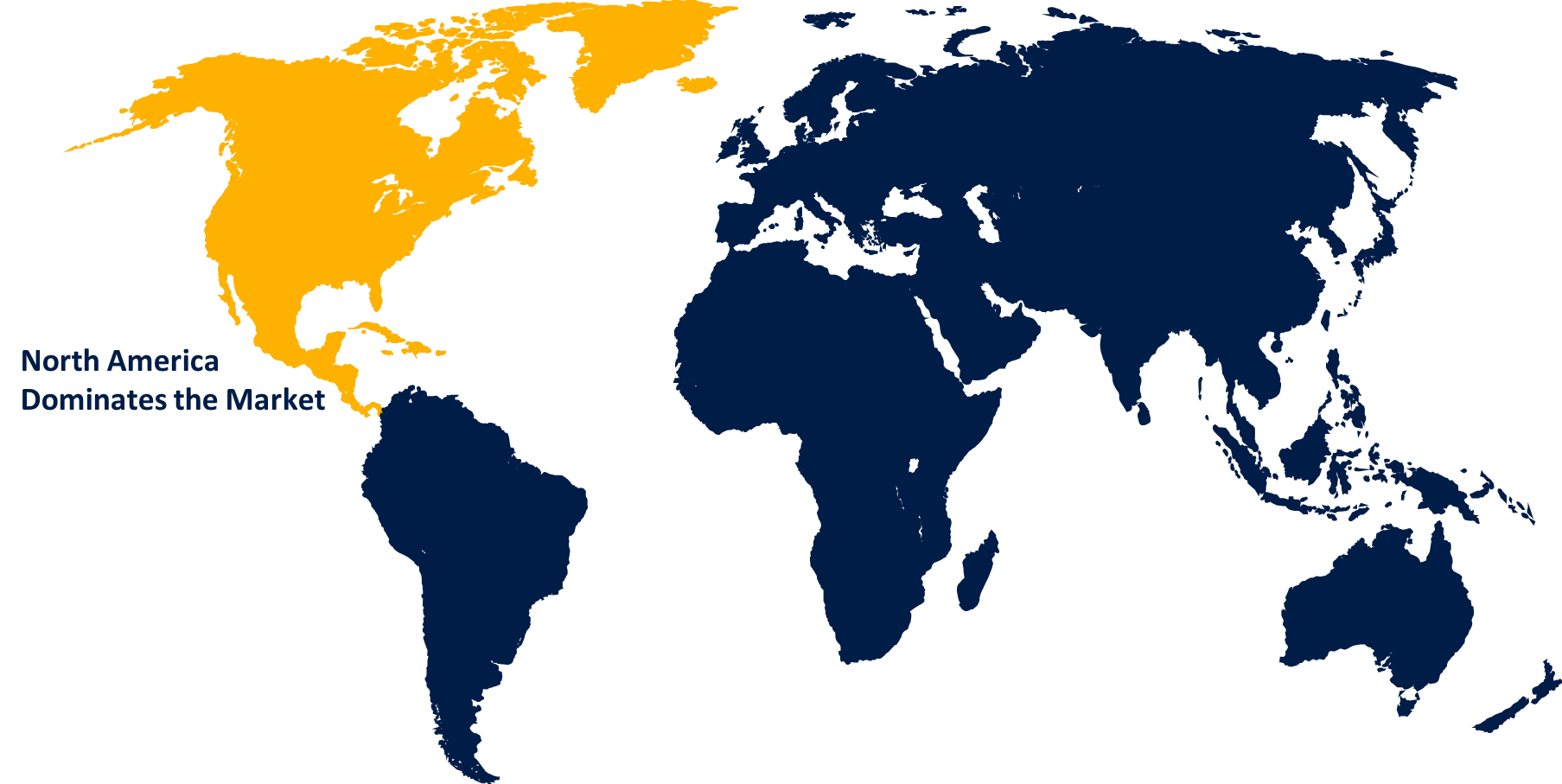Global Aircraft Carrier Market Size, Share, and COVID-19 Impact Analysis, By Type (Conventional-Powered and Nuclear-Powered), By Configuration (Catapult-Assisted Take-Off but Arrested Recovery, Short Take-Off but Arrested Recovery, and Short Take-Off but Vertical Recovery), and By Region (North America, Europe, Asia-Pacific, Latin America, Middle East, and Africa), Analysis and Forecast 2023 - 2033
Industry: Aerospace & DefenseGlobal Aircraft Carrier Market Insights Forecasts to 2033
- The Global Aircraft Carrier Market Size was valued at USD 1.4 Billion in 2023.
- The Market is Growing at a CAGR of 6.39% from 2023 to 2033
- The Worldwide Aircraft Carrier Market Size is Expected to reach USD 2.6 Billion by 2033
- Asia Pacific is Expected to Grow the fastest during the forecast period

Get more details on this report -
The Global Aircraft Carrier Market Size is Expected to reach USD 2.6 Billion by 2033, at a CAGR of 6.39% during the forecast period 2023 to 2033.
The aircraft carrier market is experiencing significant growth driven by increased defense budgets and geopolitical tensions. Key players like the U.S., China, and India are investing heavily in the development and modernization of their naval fleets. The market is characterized by advancements in nuclear propulsion, stealth technology, and automation, enhancing operational efficiency and combat capabilities. Emerging trends include the integration of unmanned systems and advanced sensor technologies. North America dominates the market, followed by Asia-Pacific, due to substantial military expenditures and technological advancements. Challenges include high costs, long development timelines, and the need for skilled personnel. Despite these, the market outlook remains positive, fueled by continuous innovation and strategic military imperatives.
Aircraft Carrier Market Value Chain Analysis
The aircraft carrier market value chain comprises multiple critical stages, from initial design to deployment and maintenance. It begins with research and development (R&D), involving collaborations between defense agencies, naval architects, and technology providers to innovate and design next-generation carriers. Following this, component manufacturing involves producing high-grade materials, propulsion systems, and avionics. The assembly phase integrates these components into a cohesive vessel, managed by major shipbuilders. Post-construction, the commissioning process includes rigorous testing and crew training. Maintenance, repair, and overhaul (MRO) services ensure operational readiness throughout the carrier's lifespan. Key stakeholders include government defense departments, contractors, subcontractors, and suppliers. The value chain is further supported by technological advancements and regulatory frameworks, ensuring enhanced capabilities and strategic military superiority.
Aircraft Carrier Market Opportunity Analysis
The aircraft carrier market presents significant opportunities driven by rising defense budgets and geopolitical tensions. Key growth areas include the development of advanced nuclear-powered carriers, which offer enhanced operational range and efficiency. Innovations in stealth technology and unmanned aerial systems integration present additional prospects, enabling greater tactical versatility and reduced crew requirements. Emerging markets, particularly in Asia-Pacific, are increasingly investing in naval capabilities, opening avenues for new contracts and collaborations. Furthermore, the push for modernization of aging fleets in established markets like North America and Europe underscores the demand for cutting-edge retrofits and upgrades.
Global Aircraft Carrier Market Report Coverage
| Report Coverage | Details |
|---|---|
| Base Year: | 2023 |
| Market Size in 2023: | USD 1.4 Billion |
| Forecast Period: | 2023-2033 |
| Forecast Period CAGR 2023-2033 : | 6.39% |
| 2033 Value Projection: | USD 2.6 Billion |
| Historical Data for: | 2019-2022 |
| No. of Pages: | 211 |
| Tables, Charts & Figures: | 120 |
| Segments covered: | By Type, By Configuration, By Region and COVID-19 Impact Analysis. |
| Companies covered:: | Lockheed Martin Corporation (The U.S.), BAE Systems PLC (The U.K.), Fincantieri SpA (Italy), General Dynamics Corporation (The U.S.), Huntington Ingalls Industries Inc. (The U.S.), Leonardo SpA (Italy), Navantia (Spain), Northrop Grumman Corporation (The U.S.), Thales Group (France), The Naval Group (France), and other key vendors. |
| Growth Drivers: | Increase the government’s attention on strengthening naval capabilities to stimulate market growth |
| Pitfalls & Challenges: | COVID-19 Empact, Challenge, Future, Growth, & Analysis |
Get more details on this report -
Market Dynamics
Aircraft Carrier Market Dynamics
Increase the government's attention on strengthening naval capabilities to stimulate market growth
Government focus on bolstering naval capabilities is significantly driving growth in the aircraft carrier market. Increased defense budgets and strategic initiatives underscore the importance of modernizing and expanding naval fleets. This shift aims to address geopolitical tensions, safeguard maritime interests, and enhance power projection capabilities. Investments in next-generation carriers with advanced technologies, such as nuclear propulsion and stealth features, are prioritized to ensure naval superiority. Additionally, government-backed R&D programs and collaborations with defense contractors foster innovation and accelerate development timelines. The emphasis on fleet modernization, including retrofits and technological upgrades, further stimulates market demand.
Restraints & Challenges
High costs associated with research, development, and construction pose significant financial barriers, often requiring substantial government funding and long-term investments. Extended development and construction timelines can lead to delays and increased expenses. Technological complexity necessitates skilled labor and advanced expertise, which can be in short supply. Additionally, maintaining and upgrading existing fleets is resource-intensive, involving continuous MRO activities. Geopolitical uncertainties and shifting defense priorities can affect budget allocations and procurement plans.
Regional Forecasts
North America Market Statistics

Get more details on this report -
North America is anticipated to dominate the Aircraft Carrier Market from 2023 to 2033. Advanced technologies, such as nuclear propulsion, stealth features, and integration of unmanned systems, are prioritized to enhance operational efficiency and combat readiness. The region benefits from robust defense budgets, leading to substantial funding for research, development, and procurement. Key players like Huntington Ingalls Industries and General Dynamics are pivotal in advancing carrier designs and construction. Additionally, government support through strategic defense initiatives and alliances further bolsters market growth. Despite challenges like high costs and lengthy development timelines, North America's aircraft carrier market remains a cornerstone of global naval power.
Asia Pacific Market Statistics
Asia Pacific is witnessing the fastest market growth between 2023 to 2033. Key countries like China and India are leading the charge, investing heavily in developing and modernizing their carrier fleets to enhance maritime security and power projection. China's advancements in carrier technology, including the development of domestically-built carriers, underscore its strategic ambitions. India, too, focuses on indigenously designed carriers to strengthen its naval capabilities. The market benefits from regional collaborations and technological innovations in propulsion systems, avionics, and unmanned aerial vehicles.
Segmentation Analysis
Insights by Type
The nuclear power type segment accounted for the largest market share over the forecast period 2023 to 2033. Nuclear-powered carriers offer significant benefits, including extended operational range without the need for frequent refueling, higher endurance, and greater speed, which are critical for sustained military operations and rapid deployment. Key players, particularly in the U.S. and increasingly in China, are prioritizing the development and deployment of nuclear-powered carriers to enhance strategic capabilities. Technological advancements in reactor design and safety features further propel this segment's growth.
Insights by Confuguration
The Catapult-Assisted Take-Off but Arrested Recovery segment accounted for the largest market share over the forecast period 2023 to 2033. This system, primarily utilized by advanced navies like the U.S. and France, enables the launch and recovery of a wide range of aircraft, including heavier and more advanced jets, enhancing operational flexibility and combat capabilities. The adoption of Electromagnetic Aircraft Launch Systems (EMALS) within CATOBAR is a key driver, offering improved efficiency and reduced stress on airframes compared to traditional steam catapults. As nations like China and India invest in carrier technology, the demand for CATOBAR systems rises, reflecting a shift towards more sophisticated naval operations.
Recent Market Developments
- In December 2020, the Indian government announced its intention to acquire a third indigenous aircraft carrier-2 (IAC-2). This aircraft carrier is expected to be a more improved version of INS Vikramaditya. The Indian government's second aircraft carrier, INS Vikrant (IAC-1), will enter service in 2022 after trials.
Competitive Landscape
Major players in the market
- Lockheed Martin Corporation (The U.S.)
- BAE Systems PLC (The U.K.)
- Fincantieri SpA (Italy)
- General Dynamics Corporation (The U.S.)
- Huntington Ingalls Industries Inc. (The U.S.)
- Leonardo SpA (Italy)
- Navantia (Spain)
- Northrop Grumman Corporation (The U.S.)
- Thales Group (France)
- The Naval Group (France)
Market Segmentation
This study forecasts revenue at global, regional, and country levels from 2023 to 2033.
Aircraft Carrier Market, Type Analysis
- Conventional-Powered
- Nuclear-Powered
Aircraft Carrier Market, Configuration Analysis
- Catapult-Assisted Take-Off but Arrested Recovery
- Short Take-Off but Arrested Recovery
- Short Take-Off but Vertical Recovery
Aircraft Carrier Market, Regional Analysis
- North America
- US
- Canada
- Mexico
- Europe
- Germany
- Uk
- France
- Italy
- Spain
- Russia
- Rest of Europe
- Asia Pacific
- China
- Japan
- India
- South Korea
- Australia
- Rest of Asia Pacific
- South America
- Brazil
- Argentina
- Rest of South America
- Middle East & Africa
- UAE
- Saudi Arabia
- Qatar
- South Africa
- Rest of the Middle East & Africa
Frequently Asked Questions (FAQ)
-
1. What is the market size of the Aircraft Carrier?The global Aircraft Carrier Market is expected to grow from USD 1.4 billion in 2023 to USD 2.6 billion by 2033, at a CAGR of 6.39% during the forecast period 2023-2033.
-
2. Who are the key market players of the Aircraft Carrier Market?Some of the key market players of the market are Lockheed Martin Corporation (The U.S.), BAE Systems PLC (The U.K.), Fincantieri SpA (Italy), General Dynamics Corporation (The U.S.), Huntington Ingalls Industries Inc. (The U.S.), Leonardo SpA (Italy), Navantia (Spain), Northrop Grumman Corporation (The U.S.), Thales Group (France), The Naval Group (France). And other key vendors.
-
3. Which segment holds the largest market share?The nuclear power segment holds the largest market share and is going to continue its dominance.
-
4. Which region dominates the Aircraft Carrier market?North America dominates the Aircraft Carrier market and has the highest market share.
Need help to buy this report?